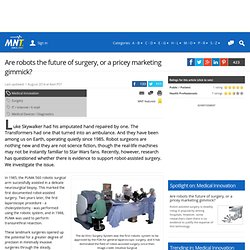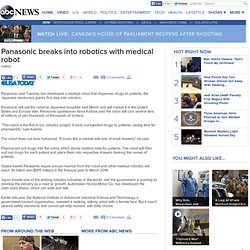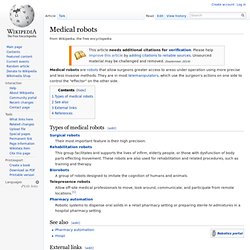

Robot. Robotic Surgery. Hand. Medical robotics: MiroSurge. The Da Vinci Robot on The Late Late Show, Ireland's most popular and prestigious television show and is the longest running chat show in the world. Medical Robotics. Medical Robotics. Are robots the future of surgery, or a pricey marketing gimmick? The da Vinci Surgery System was the first robotic system to be approved by the FDA for general laparoscopic surgery, and it has dominated the field of robot-assisted surgery since then.Image credit: Intuitive Surgical In 1985, the PUMA 560 robotic surgical arm successfully assisted in a delicate neurosurgical biopsy.

This marked the first documented robot-assisted surgery. Two years later, the first laparoscopic procedure - a cholecystectomy - was performed using the robotic system, and in 1988, PUMA was used to perform transurethral resection. These landmark surgeries opened up the potential for a greater degree of precision in minimally invasive surgeries through the steady, mechanical hand of the robot. By 1990, the first robot approved by the Food and Drug Administration (FDA) - Computer Motion's AESOP system - was assisting in endoscopic surgery. But it was not until 2000 that the operating room became acquainted with robotic surgery as we now know it.
In his column, Dr. Dr. Robots taking over to help medical research. It has been a long and stealthy takeover, but robots now dominate many leading bioscience laboratories, doing in just hours what once took days or weeks.

Now the convergence of automation with nanotechnologies, biomedics and advanced algorithms promises to take robotization of medical research much further. In May of this year, Ross King, professor of machine intelligence at the UK's University of Manchester, traveled east to talk to students at the University of Nottingham campus in Ningbo, China. His paper "Robot scientists: Automating biology and chemistry" was a vindication of theories he and colleagues first proposed almost a decade ago. In a 2004 letter to the journal Nature, they asked whether it might be possible to automate the actual "discovery" process of observation, deduction and conclusion. This would use a physically implemented robotic system that applied techniques from artificial intelligence (AI) to carry out cycles of scientific experimentation. Prof. Prof. Panasonic breaks into robotics with medical robot.
Panasonic said Tuesday has developed a medical robot that dispenses drugs to patients, the Japanese electronics giant's first step into robotics.

Panasonic will sell the robot to Japanese hospitals next March and will market it in the United States and Europe later. Panasonic spokesman Akira Kadota said the robot will cost several tens of millions of yen (hundreds of thousands of dollars). "This robot is the first in our robotics project. It sorts out injection drugs to patients, saving time for pharmacists," said Kadota. The robot does not look humanoid. All About Robotic Surgery. Medical. Medical Robotic. Medical Robotics. Machine. Medical Robots News & Articles. 10 Medical Robots That Could Change Healthcare. From microbots that scrape plaque from arteries to personal assistant robots that help care for patients, medical robots are transforming the face of healthcare. 1 of 11 Robots aren't new to healthcare.

Remember the da Vinci Surgical System, the surgical assistant the FDA approved back in 2000? Since then, the system has conducted more than 20,000 surgeries and has paved the way for robotic advancements in healthcare. In fact, vendors have introduced a number of new robots to better provide care to remote patients, help with various physical therapies and -- similar to the da Vinci system -- help perform surgery. For example, Magnetic Microbots are a group of tiny robots used in various operations, such as removing plaque from a patient's arteries or helping with ocular conditions and disease screenings. And that's no surprise considering the mounting financial difficulties the industry faces. Medical robots. Medical robots are robots that allow surgeons greater access to areas under operation using more precise and less invasive methods.

They are in most telemanipulators, which use the surgeon's actions on one side to control the "effector" on the other side. Types of medical robots[edit] Surgical robots Their most important feature is their high precision. Rehabilitation robots This group facilitates and supports the lives of infirm, elderly people, or those with dysfunction of body parts effecting movement. Biorobots A group of robots designed to imitate the cognition of humans and animals. Telepresence robots Allow off-site medical professionals to move, look around, communicate, and participate from remote locations.[1] Pharmacy automation Robotic systems to dispense oral solids in a retail pharmacy setting or preparing sterile IV admixtures in a hospital pharmacy setting See also[edit] External links[edit] References[edit]